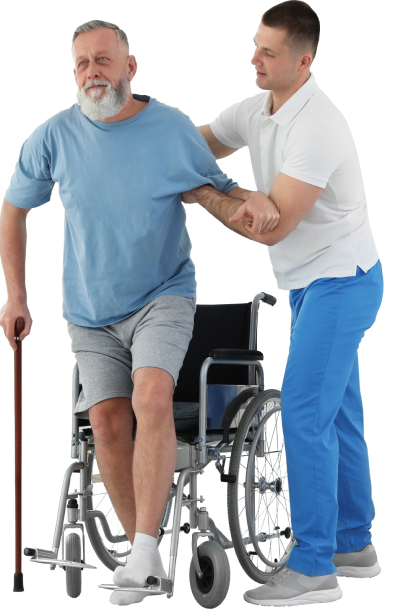This website uses cookies so that we can provide you with the best user experience possible. Cookie information is stored in your browser and performs functions such as recognising you when you return to our website and helping our team to understand which sections of the website you find most interesting and useful.
Home Care In Aberdeen Proving Ground, MD

They say that your golden years are the best years of your life. For most older Americans, that's how it should be - a time to relax, reflect, and live life in a familiar place. After all, senior citizens in the U.S. have worked tirelessly to build a better economy, serve their communities, and raise families.
However, as seniors grow older, completing daily tasks like showering and enjoying activities such as visiting the historic Aberdeen Historical Museum gets harder without someone by their side. Unfortunately, many older Americans aren't able to rely on their adult children for help. The reality in today's world is that family members do not have the skills or time to dedicate to caring for their parents. That's where Always Best Care Senior Services comes in.
Our in-home care services are for people who prefer to stay at home as they grow older but need ongoing care that family or friends cannot provide. More and more older adults prefer to live far away from long-term, institutionalized facilities and closer to the place where they feel most comfortable - their home. Home care in Aberdeen Proving Ground, MD is a safe, effective way to give your loved ones the care they need when they need it the most.

 Home Care Services
Home Care Services
- Home Care in Aberdeen Proving Ground, MD
- The Always Best Care Difference
- Types of In-home Care in Aberdeen Proving Ground, MD
- Benefits of Home Care in Aberdeen Proving Ground, MD
- Aging in Place: The Preferred Choice for Most Seniors
- Affordable Care Plans
- Compassionate Care. Trusted Caregivers
- Assisted Living Referral Services
- Taking the First Step with Always Best Care
 Service Areas
Service Areas
The Always Best Care Difference
Since 1996, Always Best Care has provided non-medical in-home care for seniors to help them maintain a healthy lifestyle as they get older. We are proud to have helped more than 25,000 seniors maintain higher levels of dignity and respect. We focus on providing seniors with the highest level of in-home care available so that they may live happily and independently.
Unlike some senior care companies, we genuinely want to be included in our clients' lives. We believe that personalized care is always the better option over a "one size fits all" approach. To make sure our senior clients receive the best care possible, we pair them with compassionate caregivers who understand their unique needs. That way, they may provide care accordingly without compromising their wellbeing.
The Always Best Care difference lies in life's little moments - where compassionate care and trustworthy experience come together to help seniors live a fruitful, healthy life. Whether you are an aging adult that can't quite keep up with life's daily tasks or the child of a senior who needs regular in-home services, Always Best Care is here to help.
“Always Best care is the best! Their caregiver is very nice with respective attitude. They”
“I am a past client of this provider My mother passed away two months ago after”
“I am a past client of this provider ABC Upper Chesapeake provided excellent and compassionate care”
“I met with Elaine Gill as we needed a secure place for my Dad. She”
“I cannot really find the words to say how wonderful the staff is at Always”
“I interviewed this provider I used Always Best Care to care for my parents who happen”
“I used Always Best Care to care for my parents who happen to live in”
“I am a past client of this provider I cannot really find the words to say”
“I interviewed this provider Elaine is professional, knowledgeable, and has a heart for people. Her recommendations”
“I interviewed this provider When we needed help getting our Father the proper care we were”
“Always Best care is the best! Their caregiver is very nice with respective attitude. They are all expert and knows their job very well in all ages. I never regret that their service to take care of my grandmother. They are trustworthy, respectful, honest and passionate to their work. I highly recommend them on their work.”
“I am a past client of this provider My mother passed away two months ago after nearly four years of coverage from the team members of ABC Upper Chesapeake. Mom and I were both very pleased with the coverage. ABC was most congenial to do their best to provide Mom with caretakers whom we found suited to Mom's personality and temperament. In the very few cases this was not so, we asked for someone else to care for Mom and this was promptly provided. All in all the caretakers were kind, friendly, competent and helpful, providing Mom with good care and company. Elaine G was very helpful in getting us in contact with the VA so that Mom was able to obtain a monthly benefit entitled to her because of Dad's service in the military. That was a great financial help to us in our particular situation. I strongly recommend this agency for the homebound and ill. They will work with you to do all they can to grant your reasonable requests. Thank you, Elaine and caretakers!”
“I am a past client of this provider ABC Upper Chesapeake provided excellent and compassionate care for my late father during his prolonged decline at age 95. The care enabled him to live in his home with my mom during his final months of life. Elaine worked with me diligently to match my parents' difficult situation with the perfect caregiver. My father was treated with dignity and gentleness when he was no longer able to care for himself at all. It gave our family great peace of mind knowing he was so well cared for.”
“I met with Elaine Gill as we needed a secure place for my Dad. She was very knowledgeable and professional. Fortunately, the second location she showed us was a good fit (Dakota Paradise). I heartily recommend Always Best Care if you want help finding a loved one the proper care.”
“I cannot really find the words to say how wonderful the staff is at Always Best Care of Upper Chesapeake: Highly competent, Comforting, caring, extremely attentive, endlessly patient and reassuring. Elaine Gill has done an amazing job at ensuring that the staff she has are just as committed to ensuring the highest quality of life for every client, as Elaine! You are on the top of my list for any further care services that my family members may need going forward.”
“I interviewed this provider I used Always Best Care to care for my parents who happen to live in another state. I met with Elaine (the owner) to discuss my options and determine the best caregiver service to meet my parents needs. She was a great help; addressed all my questions and concerns and gave me peace of mind that my parents were in good hands. Their caregiver is wonderful and very competent. I don't have to worry about them or become a detective to find out what is going on with them in Maryland. Although my parents were a little skeptical at first, Elaine and her staff have put their mind at ease and made them feel very comfortable about the entire experience. They both feel much safer now and happier that they are able to stay in the home that they love. I am comforted in knowing that my parents are receiving quality care and they are in the capable hands of Elaine and her staff at Always Best Care. Words can not express my sincere gratitude for the awesome care provided to my parents.”
“I used Always Best Care to care for my parents who happen to live in another state. I met with Elaine (the owner) to discuss my options and determine the best caregiver service to meet my parents needs. She was a great help; addressed all my questions and concerns and gave me peace of mind that my parents were in good hands. Their caregiver is wonderful and very competent. I don't have to worry about them or become a detective to find out what is going on with them in Maryland. Although my parents were a little skeptical at first, Elaine and her staff have put their mind at ease and made them feel very comfortable about the entire experience. They both feel much safer now and happier that they are able to stay in the home that they love. I am comforted in knowing that my parents are receiving quality care and they are in the capable hands of Elaine and her staff at Always Best Care. Words can not express my sincere gratitude for the awesome care provided to my parents.”
“I am a past client of this provider I cannot really find the words to say how wonderful the staff is at Always Best Care of Upper Chesapeake: Highly competent, Comforting, caring, extremely attentive, endlessly patient and reassuring. Elaine Gill has done an amazing job at ensuring that the staff she has are just as committed to ensuring the highest quality of life for every client, as Elaine! You are on the top of my list for any further care services that my family members may need going forward.”
“I interviewed this provider Elaine is professional, knowledgeable, and has a heart for people. Her recommendations have been invaluable. We are thankful for Always Best! It is a 5 Star Company!!”
“I interviewed this provider When we needed help getting our Father the proper care we were recommended to Elaine and ABC. It was the right move. Fortunately for us the second location she showed us was the right fit. It's been a difficult time and having their expertise eased our concerns.”
What is Non-Medical Senior Care in Aberdeen Proving Ground, MD?

Home is where the heart is. While that saying can sound a tad cliche, it is especially true for many seniors living in America. When given a choice, older adults most often prefer to grow older at home. An AARP study found that three out of four adults over the age of 50 want to stay in their homes and communities as they age.

When you begin to think about why, it makes sense. Home offers a sense of security, comfort, and familiarity.

The truth is, as we age, we begin to rely on others for help. When a family is too busy or lives too far away to fulfill this role, in-home senior care is often the best solution. Home care services allow seniors to enjoy personal independence while also receiving trustworthy assistance from a trained caregiver.

At Always Best Care, we offer a comprehensive range of home care services to help seniors stay healthy while they get the help they need to remain independent. As your senior loved one gets older, giving them the gift of senior care is one of the best ways to show your love, even if you live far away.

Types of Elderly Care in Aberdeen Proving Ground, MD
To give our senior clients the best care possible, we offer a full spectrum of in-home care services:

Personal Care Services
If your senior loved one has specific care needs, our personal care services are a great choice to consider. Personal care includes the standard caregiving duties associated with companion care and includes help with tasks such as dressing and grooming. Personal care can also help individuals with chronic conditions like diabetes.
Common personal care services include assistance with:
- Eating
- Mobility Issues
- Incontinence
- Bathing
- Dressing
- Grooming


Home Helper Services
Sometimes, seniors need helpful reminders to maintain a high quality of life at home. If you or your senior has trouble with everyday tasks like cooking, our home helper services will be very beneficial.
Common home helper care services include assistance with:
- Medication Reminders
- Meal Preparation
- Pet Care
- Prescription Refills
- Morning Wake-Up
- Walking
- Reading


Companionship Services
Using this kind of care is a fantastic way to make life easier for you or your senior loved one. At Always Best Care, our talented caregivers often fill the role of a companion for seniors. That way, older adults can enjoy their favorite local activities, such as visiting APG Medium Park with friends while also receiving the care they need daily or weekly.
Common companionship services include:
- Grocery Shopping
- Transportation to Appointments
- Nutritional Assistance
- Conversation
- Planning Outings
- Completing Errands
- Transportation to Community
- Events and Social Outings


Respite Care Services
According to AARP, more than 53 million adults living in the U.S. provide care to someone over 50 years old. Unfortunately, these caregivers experience stress, exhaustion, and even depression. Our respite care services help family caregivers address urgent obligations, spend time with their children, and enjoy nearby activities. Perhaps more importantly, respite care gives family members time to recharge and regroup. Taking personal time to de-stress reduces the risk of caregiver burnout. So, if you've always wanted to eat at the local Prost German Restaurant Aberdeen, MD or visit Aberdeen Proving Ground - Edgewood Area - South Gate, don't feel bad. Doing so is great for both you and your loved one.
At the end of the day, our goal is to become a valuable part of your senior's daily routine. That way, we may help give them the highest quality of life possible. We know that staying at home is important for your loved one, and we are here to help make sure that is possible.
If you have been on the fence about non-medical home care, there has never been a better time than now to give your senior the care, assistance, and companionship they deserve.

Benefits of Home Care in Aberdeen Proving Ground, MD
Always Best Care in-home services are for older adults who prefer to stay at home but need ongoing care that friends and family cannot provide. In-home care is a safe, effective way for seniors to age gracefully in a familiar place and live independent, non-institutionalized lives. The benefits of non-medical home care are numerous. Here are just a few reasons to consider senior care services from Always Best Care:
Always Best Care offers a full array of care options for patients at all levels of health. With our trusted elderly care services, your loved one will receive the level of care necessary for them to enjoy the highest possible quality of life.
Request More Information
Aging in Place: The Preferred Choice for Most Seniors
While it's true that some seniors have complicated medical needs that prevent them from staying at home, aging in place is often the best arrangement for seniors and their families. With a trusted caregiver, seniors have the opportunity to live with a sense of dignity and do so as they see fit - something that is unavailable to many older people today.
In-home care makes it possible for millions of seniors to age in place every year. Rather than moving to a strange nursing home, seniors have the chance to stay at home where they feel the happiest and most comfortable.
Here are just a few of the reasons why older men and women prefer to age at home:
How much does a senior's home truly mean to them?
A study published by the American Society on Aging found that more than half of seniors say their home's emotional value means more than how much their home is worth in monetary value. It stands to reason, then, that a senior's home is where they want to grow old.
With the help of elderly care in Aberdeen Proving Ground, MD, seniors don't have to age in a sterilized care facility. Instead, they can age gracefully in the place they want to be most: their home. In contrast, seniors who move to a long-term care facility must adapt to new environments, new people, and new systems that the facility implements. At this stage in life, this kind of drastic change can be more harmful than helpful.
Institutional care facilities like nursing homes often put large groups of people together to live in one location. On any given day, dozens of staff members and caregivers run in and out of these facilities. Being around so many new people in a relatively small living environment can be dangerous for a seniors' health and wellbeing. When you consider that thousands of seniors passed away in nursing homes during the COVID-19 pandemic, opting for in-home care is often a safer, healthier choice for seniors.
Aging in place has been shown to improve seniors' quality of life, which helps boost physical health and also helps insulate them from viral and bacterial risks found in elderly living facilities.
For many seniors, the ability to live independently with assistance from a caregiver is a priceless option. With in-home care, seniors experience a higher level of independence and freedom - much more so than in other settings like a nursing home. When a senior has the chance to age in place, they get to live life on their own terms, inside the house that they helped make into a home. More independence means more control over their personal lives, too, which leads to increased levels of fulfillment, happiness, and personal gratification. Over time, these positive feelings can manifest into a healthier, longer life.
More independence, a healthier life, and increased comfort are only a few benefits of aging in place. You have to take into consideration the role of cost and convenience. Simply put, it's usually easier and more affordable to help seniors age in place than it is to move them into an institutional care facility. According to the US Department of Housing and Urban Development, seniors who age in the comfort of their homes can save thousands of dollars per month.
In-home care services from Always Best Care, for instance, are often less expensive than long-term solutions, which can cost upwards of six figures per year. To make matters worse, many residential care facilities are reluctant to accept long-term care insurance and other types of payment assistance.
With Always Best Care's home care services, seniors and their families have a greater level of control over their care plans. In-home care gives seniors the chance to form a bond with a trusted caregiver and also receive unmatched care that is catered to their needs. In long-term care facilities, seniors and their loved ones have much less control over their care plan and have less of a say in who provides their care.

Affordable Care
In-home care is a valuable resource that empowers seniors to age in place on their own terms. However, a big concern for many families and their loved ones is how much in-home care costs. If you're worried that in-home care is too expensive, you may be pleasantly surprised to learn that it is one of the most affordable senior care arrangements available.
Typically, hiring an Always Best Care in-home caregiver for a few hours a week is more affordable than sending your loved one to a long-term care facility. This is true even for seniors with more complex care needs.
At Always Best Care, we will work closely with you and your family to develop a Care Plan that not only meets your care needs, but your budget requirements, too. Once we discover the level of care that you or your senior need, we develop an in-home care plan that you can afford.
In addition to our flexible care options, families should also consider the following resources to help offset potential home care costs:

Compassionate Care. Trusted Caregivers.
When you or your senior loved one needs assistance managing daily tasks at home, finding a qualified caregiver can be challenging. It takes a special kind of person to provide reliable care for your senior loved one. However, a caregiver's role involves more than meal preparation and medication reminders. Many seniors rely on their caregivers for companionship, too.
Our companion care services give seniors the chance to socialize in a safe environment and engage in activities at home. These important efforts boost morale and provide much-needed relief from repetitive daily routines. A one-on-one, engaging conversation can sharpen seniors' minds and give them something in which to be excited.
At Always Best Care, we only hire care providers that we would trust to care for our own loved ones. Our senior caregivers in Aberdeen Proving Ground, MD understand how important it is to listen and communicate with their seniors. A seemingly small interaction, like a short hug goodbye, can make a major difference in a senior's day. Instead of battling against feelings of isolation, seniors begin to look forward to seeing their caregiver each week.
Understanding the nuances of senior care is just one of the reasons why our care providers are so great at their job.
Unlike some senior care companies, our caregivers must undergo extensive training before they work for Always Best Care. In addition, our caregivers receive ongoing training throughout the year. This training ensures that their standard of care matches up to the high standards we've come to expect. During this training, they will brush up on their communication skills, safety awareness, and symptom spotting. That way, your loved one receives the highest level of non-medical home care from day one.
Assisted Living Referral Services
While it's true that many seniors prefer to age at home, sometimes in-home care isn't the best fit. For those seniors and their families, choosing an assisted living facility makes more sense. Unfortunately, finding the optimal care facility is easier said than done in today's day and age. That's when Always Best Care's assisted living referral services begin to make a lot of sense.
Assisted living is a form of housing intended for seniors who require varying degrees of medical and personal attention. Accommodations may include single rooms, apartments, or shared living arrangements. Assisted living communities are typically designed to resemble a home-like environment and are physically constructed to encourage the independence of residents.

At assisted living communities, seniors receive help with daily activities such as bathing, dressing, and eating. They may also benefit from coordination of services with outside healthcare providers, and monitoring of resident activities to ensure their health, safety, and well-being. Caregivers who work at assisted living communities can also provide medication administration and personal care services for older adults.
Other services offered within assisted living communities can include some or all of the following:
- Housekeeping
- Laundry
- Recreational Activities
- Social Outings
- Emergency Medical Response
- Medication Monitoring
- Family Visitation
- Personal Care

At Always Best Care, our representatives can match your senior's emotional, physical, and financial needs with viable assisted living communities nearby. Results are based on comparative data, so you can select the best choice for you or your loved one.
Always Best Care works closely with local senior living communities to gain valuable knowledge that we then use to help seniors and their loved ones make informed decisions. This information can include basic care and rent, resident availability, and services provided. Because Always Best Care is compensated by these communities, we provide senior living referral services at no extra cost to you.
Some of the most popular assisted living communities to consider in our area include the following:
- Dacota Assisted Living
- Chimes Inc
- Covenant Care Assisted Living
- Margaret Nahrgang
- Liv-N-Well Asst Living
- Vpcbh

For many seniors, moving into a senior living community revolves around how and when they want to make a transition to more involved care. Some seniors are more proactive about transitioning to independent living. Others choose to remain home until their care needs or other requirements are satisfied. Remember - our staff is here to help. Contact our office today to learn more about assisted living communities and how we can find a facility that exceeds your expectations.

Taking the First Step with Always Best Care
The first step in getting quality in-home care starts with a personal consultation with an experienced Always Best Care Care Coordinator. This initial consultation is crucial for our team to learn more about you or your elderly loved one to discover the level of care required. Topics of this consultation typically include:
A discussion of your needs and how our trained caregivers can offer assistance in the most effective way

A draft of your care plan, which includes highly detailed notes and a framework for the care that you or your senior will receive

Discuss payment options and help coordinate billing with your insurance provider

Our caregivers are trained to spot changes that clients exhibit, like mental and physical decline. As your trusted senior care company, we will constantly assess and update your Care Plan to meet any new emotional, intellectual, physical, and emotional needs.
If you have never considered in-home care before, we understand that you and your family may have concerns about your Care Plan and its Care Coordinator. To help give you peace of mind, know that every team member and caregiver must undergo comprehensive training before being assigned to a Care Plan.
At the end of the day, we only hire the best of the best at Always Best Care. Whether you need home care in Aberdeen Proving Ground, MD 24-hours a day or only need a respite for a couple of hours, we are here to serve you.
When you're ready, we encourage you to contact your local Always Best Care representative to set up a Care Consultation. Our Care Coordinators would be happy to meet with you in person to get to know you better, discuss your needs, and help put together a personalized Care Plan specific to your needs.

Latest News in Aberdeen Proving Ground, MD
Explosive Ordnance Disposal master sergeant completes career at 20th CBRNE Command
Walter Hamhttps://www.army.mil/article/286686/explosive_ordnance_disposal_master_sergeant_completes_career_at_20th_cbrne_command
ABERDEEN PROVING GROUND, Md. – A U.S. Army Explosive Ordnance Disposal master sergeant completed his more than two decades of Army service at the nation’s premier multifunctional Chemical, Biological, Radiological, Nuclear, Explosives (CBRNE) formation.Master Sgt. Thomas C. Holk retired from the U.S. Army at the 20th CBRNE Command on Aberdeen Proving Ground, Maryland.During his time at the 20th CBRNE Command, Holk served in a variety of leadership positions, including serving as the Weapons of Mass Destruction Coord...
ABERDEEN PROVING GROUND, Md. – A U.S. Army Explosive Ordnance Disposal master sergeant completed his more than two decades of Army service at the nation’s premier multifunctional Chemical, Biological, Radiological, Nuclear, Explosives (CBRNE) formation.
Master Sgt. Thomas C. Holk retired from the U.S. Army at the 20th CBRNE Command on Aberdeen Proving Ground, Maryland.
During his time at the 20th CBRNE Command, Holk served in a variety of leadership positions, including serving as the Weapons of Mass Destruction Coordination Team 5 noncommissioned officer-in-charge, Secretary of the General Staff Sergeant Major, Command Judge Advocate officer manager and G-35 operations plans special projects officer.
Headquartered on Aberdeen Proving Ground, Maryland, in Northeast Maryland’s science, technology and security corridor, the 20th CBRNE Command is home to the majority of the Active-Duty U.S. Army’s EOD and Chemical, Biological, Radiological, Nuclear (CBRN) units, as well as the 1st Global Field Medical Laboratory, CBRNE Analytical and Remediation Activity, Weapons of Mass Destruction Coordination Teams and Nuclear Disablement Teams.
Soldiers and Army civilians from the 20th CBRNE Command deploy from 19 bases in 16 states to confront and defeat the world’s most dangerous hazards in support of joint, interagency and multinational operations.
In addition to confronting and defeating explosive devices in numerous other Army EOD units, Holk served in two elite Army EOD units, the 28th Ordnance Company (EOD Airborne) and the 21st Ordnance Company (EOD WMD).
The 21st EOD Company (WMD) was activated at Kirtland Air Force Base, New Mexico, in 1998 to respond to improvised nuclear devices and radiological dispersal devices. The 28th EOD Company (Airborne) was established in 2011 to support special mission units, including the 75th Ranger Regiment.
Both units have rigorous selection processes.
Holk deployed to Afghanistan five times and supported the 75th Ranger Regiment and the 1st Special Forces Group.
Col. Scott J. Smith, the chief of staff for the 20th CBRNE Command, hosted the widely attended ceremony. Brig Gen. W Bochat, the commanding general of the 20th CBRNE Command, and Command Sgt. Maj. Dave Silva, the senior enlisted leader for the command, attended the event, together with Col. Phillip P. Murrell, the deputy commander.
Smith said Holk had made an enduring impact in the lives of the Soldiers he served with and led during his 20 years in uniform.
“This is what Master Sergeant Holk’s legacy really is – it is the difference he has made over 20 years in the lives of real people – real American Soldiers – and the impact for the better he has had in their lives,” said Smith.
“He has given everything to be the best Soldier and leader he can be because he cares for others,” said Smith. “He has given his all and for that we are truly grateful and that is why saying goodbye today is such an honor.”
Holk thanked the many Army leaders, Soldiers and Army civilians that he served with at the 20th CBRNE Command and in the lifesaving and mission-enabling EOD profession.
“The thing that truly matters is the impact that people have had on me throughout my career,” said Holk.
Forging forward together: Welcoming Col. Troy S. Johnson as U.S. Army Garrison Aberdeen Proving Ground Commander
Emily Myershttps://www.army.mil/article/286685/forging_forward_together_welcoming_col_troy_s_johnson_as_u_s_army_garrison_aberdeen_proving_ground_commander
Aberdeen Proving Ground, Md. – Col. Troy S. Johnson took command of U.S. Army Garrison Aberdeen Proving Ground (USAG APG) on June 6, 2025, with a clear vision: to foster open communication, strengthen partnerships, and build on a storied history of innovation and service.As he settles into his new role, Col. Johnson brings more than three decades of Army experience—five combat tours, a breadth of leadership positions, and a steadfast commitment to teamwork—to the Army’s oldest active proving ground....
Aberdeen Proving Ground, Md. – Col. Troy S. Johnson took command of U.S. Army Garrison Aberdeen Proving Ground (USAG APG) on June 6, 2025, with a clear vision: to foster open communication, strengthen partnerships, and build on a storied history of innovation and service.
As he settles into his new role, Col. Johnson brings more than three decades of Army experience—five combat tours, a breadth of leadership positions, and a steadfast commitment to teamwork—to the Army’s oldest active proving ground.
A Journey from Enlisted Soldier to Garrison Commander
A native of Wakefield, Virginia, Col. Johnson began his Army career in 1994, enlisting fresh out of high school. Eight years later, after demonstrating exceptional aptitude and leadership potential, he earned his commission as a Quartermaster Officer through Officer Candidate School at Fort Benning, Georgia. His academic achievements include a Bachelor of Science in Business Management with a Minor in Finance from the University of Maryland University College, and a Master of Strategic Studies from the U.S. Army War College—the capstone of a professional military education that also features the U.S. Army Command and General Staff College and the Combined Logistics Officer Career Course.
Over the years, Col. Johnson steadily progressed through increasingly complex roles: from platoon leader in supply and services to battalion commander, and across multiple staff assignments in divisions spanning the globe. He commanded the 54th Mortuary Affairs Company at Fort Lee, Virginia, served as Deputy Director of Logistics for U.S. Forces Japan in Tokyo, and led the Army Field Support Battalion at Fort Hood, Texas. Most recently, he served as the State Inspector General for the Maryland National Guard, where he oversaw readiness, accountability, and the welfare of Soldiers across the state.
A Leader Honored by Service
His distinguished record is reflected in a ribbon rack that includes the Bronze Star, Defense Meritorious Service Medal, Meritorious Service Medal, Joint Commendation Medal, Army Commendation Medal, and Army Achievement Medal—alongside the Air Assault and Parachutist Badges. These decorations underscore both combat valor and sustained excellence in staff and command roles.
Yet, Col. Johnson readily credits his teams. “Every assignment—from convoy operations to the complexities of mortuary affairs—taught me one thing: mission success depends on the soldiers beside you,” he says. “Their ingenuity, resilience, and unwavering dedication are what truly earn the awards.”
Looking Ahead at APG
When asked what he most looks forward to at APG, Col. Johnson’s enthusiasm is palpable.
“I am eagerly anticipating the opportunity to engage with the exceptional personnel at Aberdeen Proving Ground,” he says.He also emphasizes the importance of community ties:“I look forward to strengthening our partnerships with the local community.”
APG has long been a hub, not only of advanced defense research and development, but also of close collaboration with civilian stakeholders. From technology transfers to family programs and local economic impact, Garrison leadership plays a critical role in ensuring the installation’s success and its positive footprint in Harford County and beyond.
First Impressions and Surprises
Col. Johnson’s transition to APG has yielded both affirmation and surprise.
“What I find particularly commendable about APG is the strong sense of community and camaraderie among the personnel,” he notes.He also appreciates the installation’s historic legacy:“The shared pride in our collective mission and the commitment to excellence are truly inspiring. Furthermore, the historical significance of this site and its vital role in advancing defense technology provide a rich backdrop to our efforts here.”
The most striking aspect for the new commander has been the depth of collaboration across organizations.
“I have been pleasantly surprised by the remarkable level of collaboration that exists among the various departments and units,” he says. “The readiness of individuals to share knowledge speaks volumes about the robust culture of teamwork and innovation at APG.”
Commitment to Transparency and Dialogue
At the core of Col. Johnson’s leadership philosophy is a belief in transparent communication.
“I would like the community to know that I am profoundly committed to supporting both our military personnel and the community that surrounds us,” he says. “I value transparency and open dialogue, and I am eager to hear from both the team at APG and the residents of Aberdeen.”
A Family Rooted in Service
Behind every Army leader stands a supportive family, and Col. Johnson is no exception. He and his wife, Shanna, are the proud parents of three children: Alexis, Troy II, and Sean.
“Their sacrifices, encouragement, and patience have allowed me to serve at every level of command,” he says. “I look forward to showing them the community here and involving them in APG’s family events.”
An Open Invitation
Col. Johnson extends an open invitation:
“I would like to take this opportunity to express my enthusiasm for the chance to work alongside everyone. I look forward to fostering connections and exploring the many avenues of collaboration available to us as we uphold our mission at APG. Please feel free to reach out to share your ideas and insights; together, we can make a meaningful impact.”
With his extensive experience, steadfast commitment, and genuine passion for service, Col. Johnson is poised to lead APG into its next chapter—one defined by innovation, partnership, and shared success.
Master Explosive Ordnance Disposal tech completes career at 20th CBRNE Command
DVIDShttps://www.dvidshub.net/news/501687/master-explosive-ordnance-disposal-tech-completes-career-20th-cbrne-command
ABERDEEN PROVING GROUND, Md. – A U.S. Army Explosive Ordnance Disposal master sergeant completed his more than two decades of Army service at the nation’s premier multifunctional Chemical, Biological, Radiological, Nuclear, Explosives (CBRNE) formation.Master Sgt. Thomas C. Holk retired from the U.S. Army at the 20th CBRNE Command on Aberdeen Proving Ground, Maryland, June 23.During his time at the 20th CBRNE Command, Holk served in a variety of leadership positions, including serving as the Weapons of Mass Destruct...
ABERDEEN PROVING GROUND, Md. – A U.S. Army Explosive Ordnance Disposal master sergeant completed his more than two decades of Army service at the nation’s premier multifunctional Chemical, Biological, Radiological, Nuclear, Explosives (CBRNE) formation.
Master Sgt. Thomas C. Holk retired from the U.S. Army at the 20th CBRNE Command on Aberdeen Proving Ground, Maryland, June 23.
During his time at the 20th CBRNE Command, Holk served in a variety of leadership positions, including serving as the Weapons of Mass Destruction Coordination Team 5 noncommissioned officer-in-charge, Secretary of the General Staff Sergeant Major, Command Judge Advocate officer manager and G-35 operations plans special projects officer.
Headquartered on Aberdeen Proving Ground, Maryland, in Northeast Maryland’s science, technology and security corridor, the 20th CBRNE Command is home to the majority of the Active-Duty U.S. Army’s EOD and Chemical, Biological, Radiological, Nuclear (CBRN) units, as well as the 1st Global Field Medical Laboratory, CBRNE Analytical and Remediation Activity, Weapons of Mass Destruction Coordination Teams and Nuclear Disablement Teams. Soldiers and Army civilians from the 20th CBRNE Command deploy from 19 bases in 16 states to confront and defeat the world’s most dangerous hazards in support of joint, interagency and multinational operations.
In addition to confronting and defeating explosive devices in numerous other Army EOD units, Holk served in two elite Army EOD units, the 28th Ordnance Company (EOD Airborne) and the 21st Ordnance Company (EOD WMD).
The 21st EOD Company (WMD) was activated at Kirtland Air Force Base, New Mexico, in 1998 to respond to improvised nuclear devices and radiological dispersal devices. The 28th EOD Company (Airborne) was established in 2011 to support special mission units, including the 75th Ranger Regiment.
Both units have rigorous selection processes.
Holk deployed to Afghanistan five times and supported the 75th Ranger Regiment and the 1st Special Forces Group.
Col. Scott J. Smith, the chief of staff for the 20th CBRNE Command, hosted the widely attended ceremony. Brig Gen. W Bochat, the commanding general of the 20th CBRNE Command, and Command Sgt. Maj. Dave Silva, the senior enlisted leader for the command, attended the event, together with Col. Phillip P. Murrell, the deputy commander.
Smith said Holk had made an enduring impact in the lives of the Soldiers he served with and led during his 20 years in uniform.
“This is what Master Sergeant Holk’s legacy really is – it is the difference he has made over 20 years in the lives of real people – real American Soldiers – and the impact for the better he has had in their lives,” said Smith. “He has given everything to be the best Soldier and leader he can be because he cares for others,” said Smith. “He has given his all and for that we are truly grateful and that is why saying goodbye today is such an honor.”
Holk thanked the many Army leaders, Soldiers and Army civilians that he served with at the 20th CBRNE Command and in the lifesaving and mission-enabling EOD profession.
“The thing that truly matters is the impact that people have had on me throughout my career,” said Holk.
US Army EOD officer completes 21-year military career at premier CBRNE formation
DVIDShttps://www.dvidshub.net/news/500867/us-army-eod-officer-completes-21-year-military-career-premier-cbrne-formation
ABERDEEN PROVING GROUND, Md. – An Army Explosive Ordnance Disposal officer completed his 21-year uniformed military career at the U.S. military’s premier Chemical, Biological, Radiological, Nuclear, Explosives (CBRNE) Command, June 13.Maj. Casey D. Richmond retired from the U.S. Army at the 20th CBRNE Command on Aberdeen Proving Ground, Maryland.Soldiers and Army civilians from the 20th CBRNE Command deploy from 19 bases in 16 states to confront and defeat the world’s most dangerous hazards in support of joint...
ABERDEEN PROVING GROUND, Md. – An Army Explosive Ordnance Disposal officer completed his 21-year uniformed military career at the U.S. military’s premier Chemical, Biological, Radiological, Nuclear, Explosives (CBRNE) Command, June 13.
Maj. Casey D. Richmond retired from the U.S. Army at the 20th CBRNE Command on Aberdeen Proving Ground, Maryland.
Soldiers and Army civilians from the 20th CBRNE Command deploy from 19 bases in 16 states to confront and defeat the world’s most dangerous hazards in support of joint, interagency and multinational operations.
Headquartered on Aberdeen Proving Ground, Maryland, in Northeast Maryland’s science, technology and security corridor, the 20th CBRNE Command is home to the majority of the Active-Duty Army’s EOD and Chemical, Biological, Radiological, Nuclear (CBRN) units, as well as the 1st Global Field Medical Laboratory, CBRNE Analytical and Remediation Activity, Weapons of Mass Destruction Coordination Teams and Nuclear Disablement Teams.
During his time at the 20th CBRNE Command, Richmond served in the G35 future operations section and led Weapons of Mass Destruction Coordination Team 1. WCTs deploy around the world to support combatant commanders, supported commanders and lead federal agencies.
As the WMD Coordination Team 1 chief, Richmond made numerous trips to Europe to coordinate with U.S. Army Europe-Africa for counter WMD planning, operations and exercises.
Col. Phillip P. Murrell, the deputy commander of the 20th CBRNE Command, hosted the widely attended ceremony. Col. Scott J. Smith, the chief of staff for 20th CBRNE Command, and Col. Danielle C. Taylor, the operations officer for 20th CBRNE Command, attended the ceremony.
Murrell served with Richmond twice during his time at 20th CBRNE Command.
“He led WCT 1 for two years integrating with partners throughout (EUCOM) U.S. European Command,” said Murrell. “He was the lead planner for several dynamic exercises, including Freedom Shield, Austere Challenge and Global Defender.”
Murrell also highlighted his many other accomplishments, including organizing EOD Day on the Hill where Explosive Ordnance Disposal technicians engaged with their elected representatives on Capitol Hill.
Richmond helped to find future Soldiers as the operations officer for the Nashville Army Recruiting Battalion in Nashville, Tennessee.
He also served as a company commander for the 73rd Ordnance Battalion (EOD) at the Naval Explosive Ordnance Disposal School on Eglin Air Force Base, Florida, where he molded future joint service EOD techs to clear the way for successful military operations overseas and safeguard their fellow citizens from explosive hazards at home.
A former enlisted Marine logistics specialist, Richmond served in Okinawa, Japan, and at Camp Pendleton, California. He deployed to Iraq with the 1st Marine Division in support of Operation Iraqi Freedom. He later enlisted in the Montana National Guard before commissioning into the U.S. Army through the University of Montana ROTC Grizzly Battalion.
Originally from Idaho Falls, Idaho, and Lolo, Montana, Richmond earned his bachelor’s degree in communication studies from the University of Montana and his master’s degree in business administration from California State University San Bernardino.
During his 21 years of uniformed service, Richmond traveled to 25 countries and deployed to Iraq and Afghanistan. His career took him from Djibouti in Africa to Grafenwohr, Germany.
Richmond thanked his wife, two daughters and mother who were at the ceremony for their continued support throughout his two decades in uniform.
The Richmond family will retire to California.
“I can honestly say that when I enlisted in the Marines back in 1998, I would have never guessed that I would be retiring as a major in the Army,” said Richmond.
“I had the pleasure of serving the world’s greatest country, and more importantly, serving with the best people ever from service members to civilians,” said Richmond. “I could never put into words my gratitude to each and every one of them.”
Premier US military CBRNE command supports Exercise Immediate Response
Walter T. Ham IVhttps://www.army.mil/article/286058/premier_us_military_cbrne_command_supports_exercise_immediate_response
ABERDEEN PROVING GROUND, Md. — Soldiers from the U.S. military’s premier Chemical, Biological, Radiological, Nuclear, Explosives (CBRNE) formation honed their ability to enable large-scale multinational operations during Exercise Immediate Response in Europe.American Soldiers from several 20th CBRNE Command units participated in the exercise with NATO and partner nation units.Scheduled by U.S. European Command and conducted by U.S. Army Europe-Africa, Exercise Immediate Response demonstrated seamless integration bet...
ABERDEEN PROVING GROUND, Md. — Soldiers from the U.S. military’s premier Chemical, Biological, Radiological, Nuclear, Explosives (CBRNE) formation honed their ability to enable large-scale multinational operations during Exercise Immediate Response in Europe.
American Soldiers from several 20th CBRNE Command units participated in the exercise with NATO and partner nation units.
Scheduled by U.S. European Command and conducted by U.S. Army Europe-Africa, Exercise Immediate Response demonstrated seamless integration between allied and partner forces, enhancing interoperability across air, land, cyber and CBRNE domains.
Approximately 12,000 troops participated in the annual exercise, which is part of the Defender exercise series.
Albania, Bulgaria, Croatia, Greece, Kosovo, Montenegro, North Macedonia and Slovakia hosted the multinational exercise.
Brig. Gen. W Bochat, the commanding general of the 20th CBRNE Command, visited Soldiers in the field during the exercise.
Bochat said Immediate Response demonstrated the ability of 20th CBRNE Command units to enable combat forces to close with and destroy enemy forces on a CBRNE-contested battlefield.
The exercise illustrated the 20th CBRNE Command’s ability to draw equipment from Army Prepositioned Stocks, conduct training with live chemical agents and support theater opening operations at a seaport of embarkation, said Bochat.
The 20th CBRNE Command commanding general said the exercise bolstered the collective readiness of NATO and partner nations, ensuring that they remain ready to respond decisively in times of crisis or conflict, across domains and borders.
“Leveraging our capabilities and expertise together with our NATO allies and partner nations, we stand ready to confront and defeat any CBRNE challenge and to enable our forces to fight and win against any adversary,” said Bochat.
From the 20th CBRNE Command, Chemical, Biological, Radiological, Nuclear (CBRN) specialists, Explosive Ordnance Disposal (EOD) technicians and a theater-level validation laboratory participated in the exercise.
The 20th CBRNE Command units included the Fort Stewart, Georgia-based 83rd Chemical Battalion, Fort Drum, New York-based 59th Chemical Company (Hazard Response), Fort Campbell, Kentucky-based 184th Ordnance Battalion (EOD), Fort Campbell, Kentucky-based 723rd Ordnance Company (EOD) and the Aberdeen Proving Ground, Maryland-based 1st Global Field Medical Laboratory.
Headquartered on Aberdeen Proving Ground, Maryland, in Northeast Maryland’s science, technology and security corridor, the 20th CBRNE Command is home to 75 percent of the active-duty U.S. Army’s CBRN specialists and EOD technicians, as well as the 1st Global Field Medical Laboratory, CBRNE Analytical and Remediation Activity, Weapons of Mass Destruction Coordination Teams and Nuclear Disablement Teams (Infrastructure).
Soldiers and Army civilians from the 20th CBRNE Command deploy from 19 bases in 16 states to confront and defeat the world’s most dangerous hazards in support of joint, interagency and multinational operations.
The multifunctional 20th CBRNE Command enables joint service combat operations around the world and supports Federal, state and local domestic authorities across the nation.
Disclaimer:


 410-877-3787
410-877-3787





